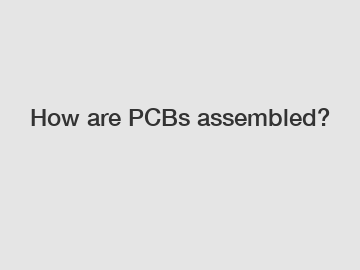How are PCBs assembled?
How are PCBs Assembled?
Have you ever wondered how those tiny electronic devices we use every day, such as smartphones and laptops, are built? Behind the sleek and compact designs lie complex components, including Printed Circuit Boards (PCBs). But how are PCBs assembled? In this article, we will delve into the fascinating world of PCB assembly, exploring the intricate process involved in bringing these crucial components to life.
1. What are PCBs?

PCBs, or Printed Circuit Boards, are the foundation of electronic devices. They are thin, flat boards made of non-conductive material, such as fiberglass or composite epoxy, with electronic components mounted on them. PCBs provide mechanical support and electrical connections for the various components that make up an electronic device.
2. The PCB Assembly Process.
The assembly of PCBs involves several crucial steps, each contributing to the final functioning of electronic devices. Let's take a closer look at these steps:
a. Design and Layout.
Before the assembly process begins, PCBs must first be designed and laid out. This involves creating a schematic diagram of the electronic circuit, determining the placement and connectivity of components on the board, and generating the necessary design files.
b. Component Placement.
Once the design is finalized, the actual assembly process starts. The first step is placing the electronic components on the PCB. This can be done either manually or with the help of automated machines. Advanced technology has enabled the use of pick and place machines, improving accuracy and efficiency in component placement.
c. Soldering.
After the components are correctly positioned, soldering is used to establish electrical connections between them and the PCB. There are two primary methods of soldering: through-hole soldering and surface mount technology (SMT). Through-hole soldering involves inserting the component leads through drilled holes on the board and soldering the bottom side. Conversely, SMT involves attaching components directly to the surface of the PCB using solder paste and a reflow oven.
d. Inspection and Testing.
Quality control is crucial to ensure that assembled PCBs meet the required specifications. Inspection and testing processes are employed to identify any defective or faulty components. Advanced inspection techniques, such as Automated Optical Inspection (AOI) and X-ray inspection, are used to verify solder connections and component placement accuracy.
e. PCB Cleaning and Coating.
To remove any excess solder flux and other contaminants left during the assembly process, PCBs undergo cleaning. This is usually done using chemical cleaners or ultrasonic baths. Additionally, for added protection against environmental factors such as moisture and dust, some PCBs receive a coating or encapsulation using materials like conformal coating or epoxy resin.
3. The Importance of Accuracy and Precision.
Accurate PCB assembly is vital for the overall functionality and reliability of electronic devices. Even the slightest misalignment or faulty connection can lead to malfunctions or complete device failure. That's why advanced techniques, machinery, and skilled operators are employed to ensure precise assembly, minimizing any potential flaws.
4. Automation and Future Trends.
Automation has revolutionized PCB assembly, increasing speed, accuracy, and cost-effectiveness. With the advent of Industry 4.0 and the Internet of Things (IoT), the demand for smaller and more intricate electronic devices is rising. Consequently, PCB assembly is also evolving towards more advanced automated processes, including robotics and artificial intelligence-assisted assembly.
In conclusion, PCB assembly is a complex and intricate process that plays a crucial role in the functioning of electronic devices. From design and placement to soldering and testing, each step requires precision and attention to detail. As technology advances, we can expect to see further automation and innovation in the PCB assembly industry. So, next time you use your smartphone or any other electronic device, remember the remarkable journey of how PCBs are assembled to bring them to life.
The company is the world’s best mintecelec.com, medical pcb assembly, pcb assembly in medical field supplier. We are your one-stop shop for all needs. Our staff are highly-specialized and will help you find the product you need.
239
0
0

Comments
All Comments (0)